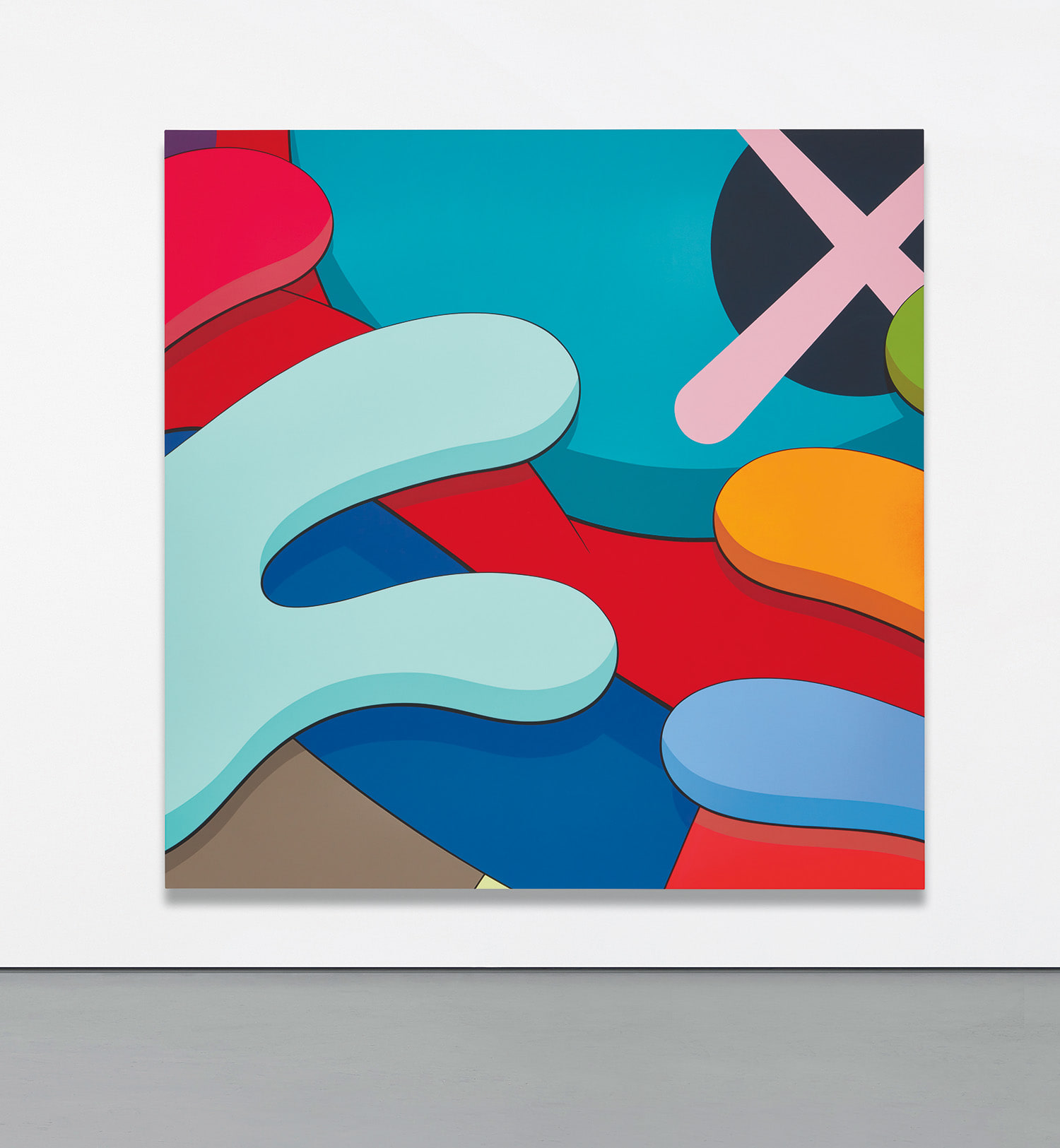



3
KAWS
UNTITLED
Full-Cataloguing
In line with the work of Takashi Murakami, Jeff Koons, Keith Haring and Andy Warhol, KAWS refuses to parse distinctions between high versus low art. His participation in the skate culture, graffiti crews, and street-art movement of the early 1990s in downtown Manhattan shaped the artist’s style and affinity for the handmade and do-it-yourself ethic. According to Germano Celant, street art, “is an abandonment of the narcissistic, opportunistic aspect—as concerns the market—of the communicational break, in favour of a fluidity that directly captures the reality of the city,” a description that aptly underscores KAWS’s work. (Germano Celant, “BD and K,” exh. cat., KAWS 1993-2010, New York, 2010, p. 47.) In 1996, Barry McGee gave KAWS a tool to open tamper-proof bolts to unlock glass panels encasing bus stop and phone booth poster ads. In major cities around the world, KAWS would surreptitiously steal posters, add his own graphics to them in acrylic paint, and then stealthily put them back.
Never intending to overpower the previous image, KAWS would weave his own painted work and strategic humour into existing compositions to stimulate a reconsideration of the advertisement’s hidden message. His painted altercations were so skilfully executed that people often assumed they were part of the original advertisement. This perfectionist mentality carried over to his paintings as illustrated by the pristine lack of visible brushstrokes in UNTITLED. By the end of 2000, KAWS had become so well-known that his masterful acrylic street paintings would last only a few hours since people would break the glass to get into the booths and steal them.
In 1997, KAWS travelled to Japan and became immersed in the country’s dedication to craftsmanship as well as its lack of a strict hierarchy between merchandise and high art. KAWS met several Japanese designers who would influence his career including Tomoaki Nagao (NIGO®), founder of A Bathing Ape, and Hikaru Iwanaga from Bounty Hunter. Their shared cultivated taste, connoisseurship, ability to influence youth culture, and most importantly, their freedom to work on their own terms profoundly resonated with the young American artist. KAWS describes, “in America, you had to choose between being a fine artist or a commercial artist... In Japan, I never felt that—they were just looking at pieces and creating objects. There was an integrity to it.” (KAWS quoted by Lucia Ferigutti, "The Supersized Sculptures of KAWS," February 8, 2016.) Evident in UNTITLED, the versatile character that KAWS first introduced in his street art, and later transformed into a highly sought-after collectible vinyl figure in collaboration with Bounty Hunter, is nowadays being exhibited as part of major works in museums around the United States, Europe, and Asia.
Given its flat, non-hierarchical application of paint that instils the entire canvas with an equal relevance, the magnified perspective of UNTITLED blurs the boundaries between figuration and abstraction. The X-ed out eye and cartoon hands only scarcely point to KAWS’s familiar and beloved cast of characters. UNTITLED lures viewers in with its attractive saturated tones and mysterious narrative, yet unlike KAWS’s typical works, the present lot pushes viewers out with its illegibility. Though the Pop artists who preceded KAWS were praised for their “refusing to make art about feelings,” (Deborah Solomon quoted by Mónica Ramírez-Montagut, “KAWS: Seeing You Seeing Yourself,” exh. cat., KAWS 1993-2010, New York, 2010, p. 126.) the present lot goes beyond Pop art’s emotional coolness to the point where we as viewers are excluded from the story taking place. Considering KAWS’s openness to exploring new personalities in his paintings rather than in his toy edition characters, UNTITLED portrays the artist’s exploration of narrative distance.
UNTITLED speaks to our digitally interconnected world where we see the emergence of a levelling of sources of information and disciplines and a disregard for conventional notions of hierarchy. The present lot participates in our digital era as it functions within this system of art production, reception and interpretation permeated by mass media and technology. Whether it is the recognisable figures from childhood cartoons or the playful and optimistic undertones of KAWS’s wide range of works, viewers of all backgrounds can relate to the message of KAWS. The artist states, “For me, all my work is personal. It is an accumulation of things that create my art. I am who I am, and I’ve never said to myself that I would become a famous graffiti artist or a famous painter. I just painted on the outside and I’m doing it inside.” (KAWS in conversation with Romain Daubriac, KAWS: XX, Clark Magazine #45, November/December 2010.)
KAWS
American | 1974To understand the work of KAWS is to understand his roots in the skateboard and graffiti crews of New York City. Brian Donnelly chose KAWS as his moniker to tag city streets beginning in the 1990s, and quickly became a celebrated standout in the scene. Having swapped spray paint for explorations in fine art spanning sculpture, painting and collage, KAWS has maintained a fascination with classic cartoons, including Garfield, SpongeBob SquarePants and The Simpsons, and reconfigured familiar subjects into a world of fantasy.
Perhaps he is most known for his larger-than-life fiberglass sculptures that supplant the body of Mickey Mouse onto KAWS' own imagined creatures, often with 'x'-ed out eyes or ultra-animated features. However, KAWS also works frequently in neon and vivid paint, adding animation and depth to contemporary paintings filled with approachable imagination. There is mass appeal to KAWS, who exhibits globally and most frequently in Asia, Europe and the United States.